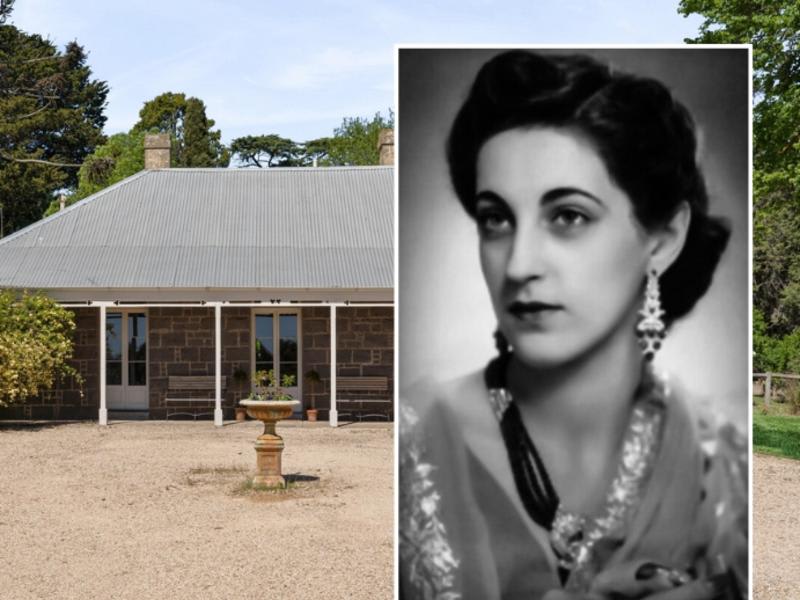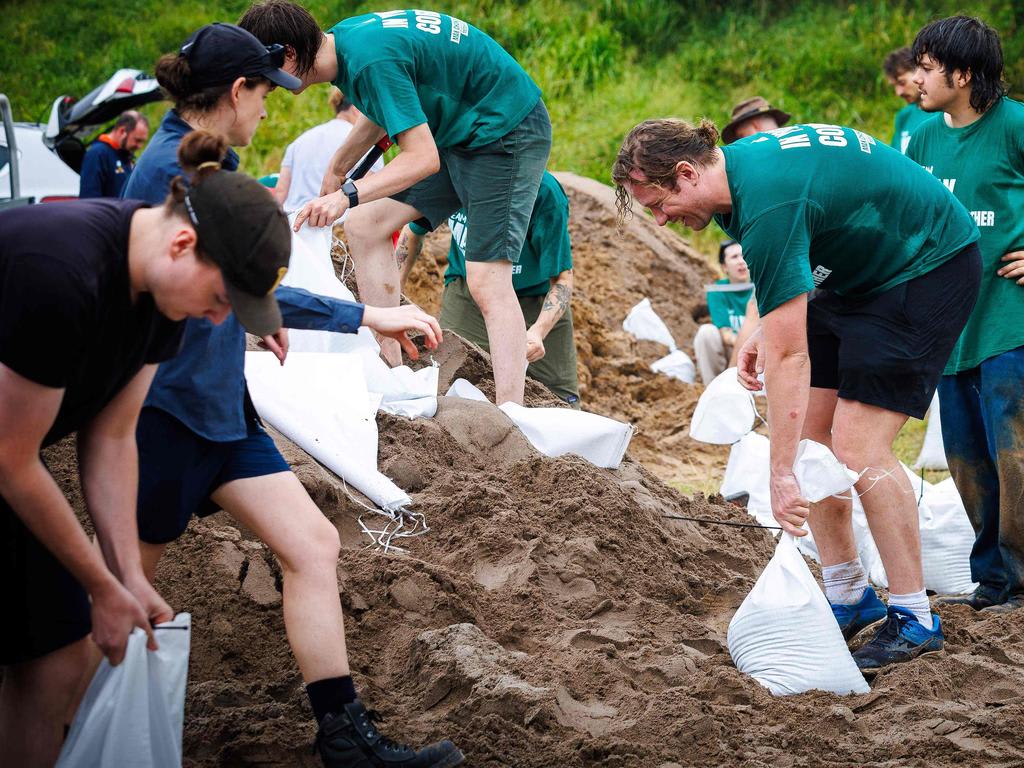
The Abbeyville homestead at 140 Fiddlers Green Rd, Kyneton, is one of two local properties previously owned by the family of Joan Falkiner, who married into Indian royalty.
Two historic Kyneton houses formerly owned by the family of an Australian heiress who became a member of Indian royalty have hit the market.
One of the homes, a 1856-built bluestone home named Abbeyville at 40 Fiddlers Green Rd, is for sale with a $2.7m-$2.95m asking range.
The second home, a circa-1850s house and cottage at 28 Piper St, has $1.3-$1.4m price hopes.
RELATED: Princess Mary’s humble childhood home revealed
Old world-style estate near Kyneton designed to showcase musical greatness
Kyneton: Home akin to Pride and Prejudice’s estates has dam perfect for Mr Darcy to swim in
The residences’ connection to Joan Falkiner, who became known as the Begum of Palanpur, India, after her marriage, dates back to when her family were wealthy merino sheep breeders in rural Victoria and New South Wales.
Broadhurst Property’s Rachel Potter said Joan’s family previously owned both the properties, with Abbeyville, once serving as an auction house.
By the early 20th century, Joan’s parents had established themselves as high-profile members of Melbourne society with their social activities often reported in newspapers.
A biography penned by Joan’s distant cousin, Australian author Suzanne Falkiner, details Joan’s romance with Taley Muhammed Khan, whom she met while travelling with her family in Germany.
At the time, Joan was aged 19 and Taley was in his 50s.
He held the title of Nawab (viceroy) of India’s Palanpur State, a protectorate of the British Empire which had a population of about 250,000 people at the time.
Taley was also an honorary aide de camp, meaning a military officer acting as an assistant, to England’s King George VI.
140 Fiddlers Green Rd, Kyneton, is named Abbeyville.
Joan Falkiner, photographed as a young woman.
A large fireplace, built-in bookshelves, dado panels and Baltic pine flooring in the formal sitting room.
Although Taley already had one wife, he and Joan became engaged.
In 1939, Joan, 21, eloped from Melbourne to India to marry Taley.
The matter became a much-talked about scandal in Australia, filling gossip columns of the day with the Australian Women’s Weekly reporting Joan’s parents did not approve of the match.
However, Joan converted to Islam to marry Taley at the Zora Mahal Palace in Palanpur.
They later had a daughter. In 1960, the Australian Women’s Weekly featured the Australian-Indian Princess Shameen, then aged 17, when she was visiting her grandparents in South Yarra.
Following Taley’s death in 1957, Joan settled in France.
The summerhouse is a favourite place to spend time in warmer weather.
The central bathroom features a heated floor and towel rail, original Victorian claw foot bath, handmade brass tapware and a skylight.
Although neither of the Kyneton homes remain in Joan’s family, they still retain a sense of history.
Abbeyville, a five-bedroom Colonial Georgian-style farmhouse, is set on a 4ha block.
It features equestrian facilities, a conservatory and pond surrounded by natural bluestone formations.
The current owners, John Webb and Merell Liddle, are downsizing after raising their three daughters at the homestead across more than three decades.
A previous resident of the house was Victorian MP Charles Young, who served in parliament between 1874 and 1892.
The property is a five-minute drive from the Kyneton township.
The couple bought Abbeyville in 1990 and were married in the music room a year later.
Their favourite part of the property is the summerhouse, which can be accessed through the kitchen or conservatory, where they enjoy hosting paella parties.
In 2001, they extended the main house, incorporating the original Baltic floorboards and oak parquetry, high ceilings, antique lighting fixtures and French doors.
Abbeyville’s formal sitting room has a fireplace, built-in bookshelves, dado panels, an antique chandelier and double doors with etched glass leading to the dining room.
And the home is believed to be haunted by a child named Violet who died as a toddler, when she formerly lived there.
Her ghost is said to sometimes walk up and down the hallway, with the sound of her footsteps faintly echoing.
28 Piper St, Kyneton, has a green landscaped garden.
The facade hides the historic renovated interiors.
The owners of 28 Piper St, Kyneton, are ex-sales and marketing manager Deb Varney and former Victoria Police senior investigator Joe D’Alo.
Their home consists of an 1850s-era brick house and cottage that dates back to 1854, known as Tom’s Cottage.
Ms Varney and Mr D’Alo described the home as an “ugly duckling” when they purchased it in 2009.
It came complete with a leaking roof, mouldy wallpaper, threadbare carpet and an outdoor toilet – “but its good bones and rich history made it worth saving”.
After his policing career, Mr D’Alo returned to study to become a qualified builder specialising in old-world craftsmanship and sustainable materials.
The home dates back to the Victorian gold rush of the 1850s.
A glass-encased conservatory allows visitors to admire the garden.
After reading a magazine article which detailed the use of hemp by French retro-fitters in centuries-old buildings, he established the Hemp Building Company which builds homes out of hempcrete, a material consisting of hemp hurd (the woody core from hemp plants turned to woodchips), lime binder and water.
He applied his expertise to transform Tom’s Cottage into Victoria’s first hempcrete project.
“Slowly and carefully peeling back the layers during renovations was an amazing journey of discovery,” Ms Varney said.
“We took the conservation approach of retaining as much original fabric as possible, including any fixtures and decorative finishes, such as the flour bag hooks still fixed to the rafters in the cellar.”
The house and cottage were both renovated with as many original features retained as possible.
Escape into the garden to enjoy the sun.
The cottage, which previously served as a land agent’s office, bakery and butcher, was inhabited by a boot repairer Tom Hickey from the 1930s to the 1980s.
During the renovation, many of Tom’s discarded tools were discovered beneath the floors including awl handles, boot polish tins and even old dance passes.
Nowadays, the one-bedroom, two-storey self-contained residence serves as a short-term rental accommodation.
A feature brick wall, crafted from a collection of recycled red bricks, within the front house.
“The cosy lounge in Tom’s Cottage, with views of the Italian-style garden courtyard, is Joe’s favourite space,” Ms Varney said.
“Overhung by a grapevine and framed by rustic brick walls, it’s a serene retreat that reflects the craftsmanship poured into the home and the incredible Italian courtyard vibe.”
And just like Abbeyville, Tom’s Cottage is thought to have its own ghost, a cheerful man nicknamed Cheery Charlie.
According to the family of a previous owner, the ghost is likely that of a former gold miner.
Sign up to the Herald Sun Weekly Real Estate Update. Click here to get the latest Victorian property market news delivered direct to your inbox.
MORE: Inside the dream homes of Australia’s top real estate agents
Fun factor on steroids at epic Aussie homes with rock climbing, water slides, motocross tracks
Australia’s most searched real estate terms 2024: Pools and granny flats






